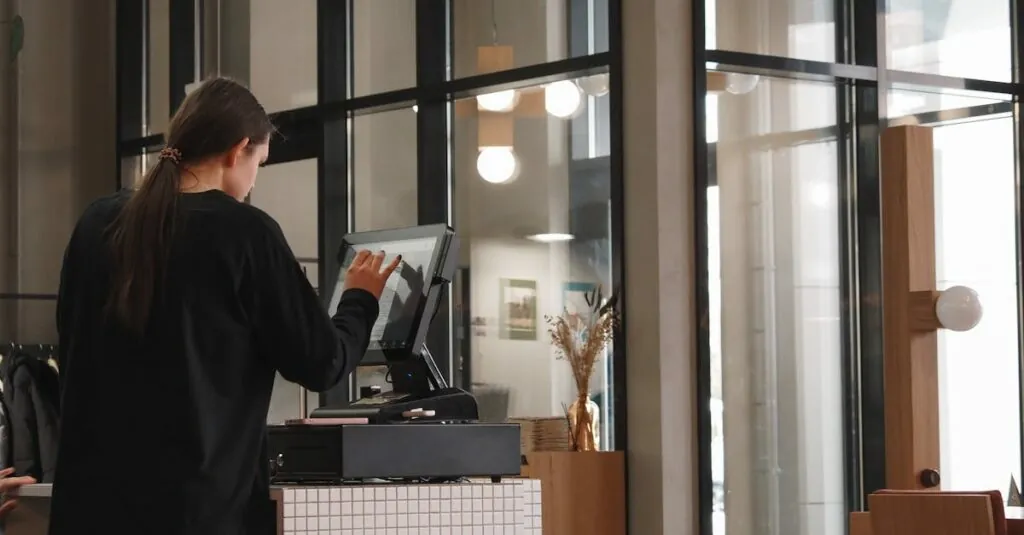Table of Contents
ToggleIn a world where shopping can happen in pajamas and delivery drones hover like eager pets, retail tech isn’t just a trend—it’s a revolution. From smart shelves that know when to restock to apps that turn shopping into a treasure hunt, the future of retail is more exciting than a surprise sale on your favorite sneakers.
Overview of Retail Tech Insights
Retail technology significantly shapes modern shopping. Many retailers adopt innovations like smart shelves that monitor inventory and automatically restock items. These systems minimize stockouts and enhance customer satisfaction.
Mobile apps also enhance the shopping experience, gamifying interactions to boost engagement. Shoppers earn rewards through game-like challenges, which keeps them returning to stores. This approach creates loyalty and incentivizes spending.
Data analytics plays a crucial role in retail tech. Retailers leverage data to understand consumer behavior, enabling personalized marketing strategies. Tailored promotions based on purchase history increase conversion rates.
Artificial intelligence transforms customer service. Chatbots provide instant support, answering questions and resolving issues quickly. Enhanced customer experiences lead to higher retention rates and improved brand loyalty.
Augmented reality reshapes product interaction. Virtual fitting rooms allow shoppers to try on clothes digitally, increasing confidence in online purchases. This technology reduces return rates, benefiting both retailers and consumers.
Integrated payment systems streamline transactions. Contactless payments and mobile wallets expedite checkout processes, improving overall shopping efficiency. In retail, speed and convenience are essential for customer satisfaction.
Retail tech insights reveal a rapidly evolving landscape. Technology’s integration into shopping is not a fleeting trend but a fundamental shift in retail operations. This transformation focuses on enhancing customer experiences and driving sales through innovative solutions.
Key Trends in Retail Technology
Retail technology continues evolving, bringing significant changes to the shopping experience. Innovations in both e-commerce and in-store technology redefine customer interactions.
E-commerce Innovations
Online shopping platforms incorporate advanced features like artificial intelligence chatbots. These tools provide immediate customer support, enhancing overall service. Personalized product recommendations drive higher conversion rates, making shopping more engaging. Augmented reality applications also allow consumers to visualize products in their own space. Increased accessibility through mobile-optimized websites helps reach a broader audience. Voice commerce is gaining traction, enabling seamless transactions through smart speakers.
In-store Technology Advancements
In physical stores, smart shelves are becoming commonplace. These devices automatically track inventory levels, ensuring products are always available. Digital price tags allow for real-time price adjustments, enhancing pricing strategies. Interactive kiosks serve to provide product information, guiding consumers through their shopping journey. Mobile payment options, such as contactless transactions, streamline checkout processes, reducing wait times. Implementation of RFID technology improves inventory management and reduces loss, enhancing operational efficiency.
Impact of Retail Tech on Consumer Experience
Retail technology significantly enhances consumer experiences by streamlining operations and creating more engaging interactions. Innovations drive how customers connect with brands, ultimately influencing their purchasing decisions.
Personalization and Customer Engagement
Personalization plays a crucial role in modern retail. Retailers leverage data analytics to gather insights on consumer behavior. This information fuels targeted marketing, increasing relevance and engagement. Apps that gamify shopping experiences motivate customers to interact with brands. Reward systems foster loyalty, encouraging repeat purchases. Personalized recommendations based on previous purchases also enhance satisfaction. By catering to individual preferences, retailers can significantly boost conversion rates, creating stronger connections between brands and consumers.
Omnichannel Strategies
Omnichannel strategies integrate various shopping channels seamlessly. Customers can transition between physical stores and online platforms effortlessly. Retailers equip teams with tools that provide consistent information across all touchpoints. This approach ensures a cohesive brand experience. Mobile apps allow for in-store navigation and offer promotions tailored to where customers are shopping. Enhanced analytics track consumer behavior, helping retailers refine strategies. With consistent service in both environments, customer loyalty strengthens significantly, fostering long-term relationships with brands.
Challenges in Adopting Retail Technology
Adopting retail technology presents several challenges for businesses. Cost concerns frequently arise as retailers invest in advanced systems, which can strain budgets, especially for small stores. Compatibility issues also emerge when integrating new technology with existing systems. Retailers must ensure that their current infrastructure can support upgrades without significant disruptions.
Training staff on new technology poses another hurdle. Employees may resist changes due to a lack of familiarity with digital tools. Successful implementation often requires comprehensive training programs that enhance staff confidence and efficiency.
Customer acceptance of new tech can also be a challenge. Some consumers may prefer traditional shopping experiences, making it essential for retailers to educate them on the benefits of adopting new solutions. Seamless integration of technology into the shopping experience is crucial to gaining customer trust and approval.
Data privacy concerns dominate discussions surrounding retail technology adoption. Customers demand assurance that their personal information remains secure. Retailers must prioritize cybersecurity measures to protect sensitive data while fostering consumer confidence in their technological advancements.
Another obstacle includes the fast-paced nature of technological advancements. Retailers often find themselves struggling to keep up with new trends, leading to the risk of obsolescence. Staying informed on emerging technologies and adapting accordingly helps retailers maintain competitive advantages.
Finally, the complexity of ensuring a cohesive omnichannel experience adds to the challenges. Integrating various platforms and tools can be daunting, yet it is critical for providing a seamless shopping experience. Retailers need to focus on strategies that unite online and offline interactions for maximum customer satisfaction.
Future of Retail Tech
Focus on advancements like artificial intelligence and augmented reality as key drivers in retail tech’s evolution. AI enhances customer service, using chatbots for instant support that leads to higher retention rates. Retailers employ data analytics to understand consumer patterns, allowing personalized marketing strategies to flourish.
Innovations such as smart shelves and digital price tags streamline inventory management and pricing. Augmented reality offers virtual fitting rooms, which contribute to consumers feeling more confident about purchases and lowering return rates. Payment systems also evolve; contactless options improve transaction efficiency, catering to the demand for faster checkouts.
Retailers recognize trends shaping the shopping landscape. The integration of mobile applications gamifies experiences, fostering engagement through rewards. Omnichannel strategies unify physical and online shopping, enhancing customer loyalty and strengthening brand connections.
Challenges accompany these technological shifts. Cost remains a significant barrier for smaller retailers, while compatibility issues with existing systems can hinder progress. Employee training on new technologies is vital to avoid resistance that could obstruct successful implementation.
Consumer acceptance of new technology also plays a critical role, making education on benefits essential. Data privacy concerns demand priority, urging retailers to bolster cybersecurity measures. The fast pace of technology growth risks obsolescence, compelling retailers to stay informed and adaptable.
Integrating various platforms adds complexity, but this cohesion maximizes customer satisfaction in an evolving retail landscape. Retail tech continuously reshapes operations, emphasizing enhancements in consumer experiences and sales.
Retail technology is fundamentally changing the way consumers shop and interact with brands. As innovations continue to emerge retailers must embrace these advancements to stay competitive. The integration of AI and augmented reality not only enhances customer experiences but also drives sales and loyalty.
However the path to adopting these technologies isn’t without challenges. Retailers need to navigate costs employee training and data privacy concerns while ensuring a seamless omnichannel experience. By staying informed and adaptable they can leverage the full potential of retail tech to create engaging shopping environments that resonate with today’s consumers. The future of retail is bright and full of possibilities for those ready to innovate.







